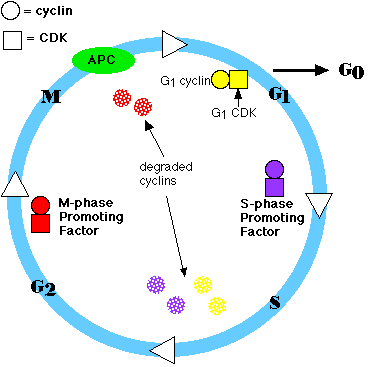The Cell Cycle
A eukaryotic cell cannot divide into two, the two into four, etc. unless two processes alternate:
- doubling of its genome (DNA) in S phase (synthesis phase) of the cell cycle
- halving of that genome during mitosis (M phase)
The period between M and S is called G1; that between S and M is G2.
 So, the cell cycle consists of:
So, the cell cycle consists of:
Control of the Cell Cycle
The passage of a cell through the cell cycle is controlled by proteins in the cytoplasm. Among the main players in animal cells are:
- Cyclins
There are 3 groups:
- G1 cyclins
- S-phase cyclins
- M-phase cyclins
Their levels in the cell rise and fall with the stages of the cell cycle.
- Cyclin-dependent kinases (CDKs)
Again, there are 3 groups:
- G1 CDKs
- S-phase CDKs
- M-phase CDKs
Their levels in the cell remain fairly stable, but each must bind the appropriate cyclin (whose levels fluctuate) in order to be activated.
They add phosphate groups to a variety of protein substrates that control processes in the cell cycle.
- The anaphase-promoting complex (APC) and other proteolytic enzymes. APC degrades the mitotic cyclins.
Steps in the cycle
- a rising level of G1 cyclins signals the cell to prepare the chromosomes for replication
- a rising level of S-phase promoting factor prepares the cell to enter S phase and duplicate its DNA (and its centrioles)
- as DNA replication continues, one of the cyclins shared by G1 and S-phase CDKs (cyclin E) is destroyed and the level of mitotic cyclins begins to rise (in G2)
- M-phase promoting factor (the complex of mitotic cyclins with M-phase CDK) initiates
- assembly of the mitotic spindle
- breakdown of the nuclear envelope
- condensation of the chromosomes
- these events take the cell to metaphase of mitosis
- at this point, the M-phase promoting factor activates the anaphase promoting complex (APC) which
- separates the sister chromatids at the metaphase plate (= anaphase), completing mitosis
- destroys the M-phase cyclins
- turns on synthesis of G1 cyclins for the next turn of the cycle.
G0
Many times a cell will leave the cell cycle, temporarily or permanently. It exits the cycle at G1 and enters a stage designated G0 (G zero). A G0 cell is often called "quiescent", but that is probably more a reflection of the interests of the scientists studying the cell cycle than the cell itself. Many G0 cells are anything but quiescent. They are busy carrying out their functions in the organism. e.g., secretion, conducting nerve impulses, attacking pathogens.
Often G0 cells are terminally differentiated: they will never reenter the cell cycle but instead will carry out their function in the organism until they die.
For other cells, G0 can be followed by reentry into the cell cycle. Most of the lymphocytes in human blood are in G0. However, with proper stimulation, such as encountering the appropriate antigen, they can be stimulated to reenter the cell cycle (at G1) and proceed on to new rounds of alternating S phases and mitosis.
21 May 1999
 So, the cell cycle consists of:
So, the cell cycle consists of: